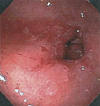Stricture rate after laparoscopic Roux-en-Y Gastric bypass with a 21-mm circular stapler: the Cleveland Clinic experience
- PMID: 19648758
- PMCID: PMC2790757
- DOI: 10.1159/000226289
Stricture rate after laparoscopic Roux-en-Y Gastric bypass with a 21-mm circular stapler: the Cleveland Clinic experience
Abstract
Objective: The objectives of this study were to report the incidence of gastrojejunal anastomic strictures that occurred in laparoscopic Roux-en-Y gastric bypass (LRYGB) surgery and to determine the time course of presentation, associated perioperative factors, and response to balloon dilation.
Subjects and methods: All 126 patients who underwent LRYGB at the Cleveland Clinic Foundation between July 2003 and February 2005 were included. We utilized a transoral 21-mm circular stapler for the gastrojejunostomy. Patients with symptoms of anastomotic strictures underwent upper endoscopy by one surgeon (B.C.). A stricture was defined by the inability to pass a 10-mm gastroscope through the anastomosis. Balloon dilation was performed to 12 mm. Records were analyzed retrospectively and statistical analysis including Pearson chi(2) statistics, Fisher's exact test and Student's t test were used when appropriate.
Results: Symptomatic anastomotic strictures occurred in 29 (23%) patients. All patients presented with nausea, vomiting and dysphagia. The median time to diagnosis was 52 days (25-309 days). Symptoms resolved after one dilation in 25 (86%) of patients. Two and three dilations were required in 1 (3.5%) and 3 (10.5%) of patients, respectively. No patients had complications or required more than 3 dilations. Age, preoperative body mass index (BMI), and intraoperative blood loss did not correlate with stricture formation. Although nonsteroidal anti-inflammatory drugs were used by 46 (41%) of patients after surgery, there was no correlation with stricture formation.
Conclusion: Symptomatic anastomotic strictures developed in nearly a quarter of patients who underwent LRYGB utilizing a transoral 21-mm circular stapled gastrojejunal anastomosis. A single endoscopic balloon dilation was usually adequate. Strictures were not predicted by perioperative factors.
Copyright 2009 S. Karger AG, Basel.
Figures
Similar articles
-
Incidence and outcome of anastomotic stricture after laparoscopic gastric bypass.J Gastrointest Surg. 2003 Dec;7(8):997-1003; discussion 1003. doi: 10.1016/j.gassur.2003.09.016. J Gastrointest Surg. 2003. PMID: 14675709
-
Outcome of endoscopic balloon dilation of strictures after laparoscopic gastric bypass.Surg Endosc. 2008 Aug;22(8):1746-50. doi: 10.1007/s00464-008-9788-0. Epub 2008 Mar 18. Surg Endosc. 2008. PMID: 18347868
-
Low anastomotic stricture rate after Roux-en-Y gastric bypass using a 21-mm circular stapling device.Obes Surg. 2012 Sep;22(9):1491-5. doi: 10.1007/s11695-012-0671-7. Obes Surg. 2012. PMID: 22714823
-
Meta-analysis of hand-sewn versus mechanical gastrojejunal anastomosis during laparoscopic Roux-en-Y gastric bypass for morbid obesity.Int J Surg. 2016 Aug;32:150-7. doi: 10.1016/j.ijsu.2016.04.024. Epub 2016 Apr 21. Int J Surg. 2016. PMID: 27107663 Review.
-
Endoscopic management of stomal stenosis after Roux-en-Y gastric bypass.Surg Endosc. 2004 Jan;18(1):56-9. doi: 10.1007/s00464-003-8919-x. Epub 2003 Nov 21. Surg Endosc. 2004. PMID: 14625732 Review.
Cited by
-
Intraoperative Endoscopy Decreases Postoperative Complications in Laparoscopic Roux-en-Y Gastric Bypass.Obes Surg. 2015 Sep;25(9):1711-5. doi: 10.1007/s11695-015-1604-z. Obes Surg. 2015. PMID: 25663175
-
Stricture Rate after Laparoscopic Roux-en-Y Gastric Bypass with a 21-mm Circular Stapler versus a 25-mm Linear Stapler.Bariatr Surg Pract Patient Care. 2015 Mar 1;10(1):33-37. doi: 10.1089/bari.2014.0048. Bariatr Surg Pract Patient Care. 2015. PMID: 25830078 Free PMC article.
-
Does Robotic Roux-en-Y Gastric Bypass Provide Outcome Advantages over Standard Laparoscopic Approaches?Obes Surg. 2018 Sep;28(9):2589-2596. doi: 10.1007/s11695-018-3228-6. Obes Surg. 2018. PMID: 29637410 Free PMC article.
-
Stenosis after use of the double-stapling technique for reconstruction after laparoscopy-assisted total gastrectomy.Surg Endosc. 2013 Oct;27(10):3683-9. doi: 10.1007/s00464-013-2945-0. Epub 2013 Apr 10. Surg Endosc. 2013. PMID: 23572225 Clinical Trial.
-
Off label use of lumen-apposing metal stent for persistent gastro-jejunal anastomotic stricture.World J Gastrointest Endosc. 2018 Jun 16;10(6):117-120. doi: 10.4253/wjge.v10.i6.117. World J Gastrointest Endosc. 2018. PMID: 29988884 Free PMC article.
References
-
- Deitel M. Overweight and obesity worldwide now estimated to involve 1.7 billion people. Obes Surg. 2003;13:329–330. - PubMed
-
- Pope GD, Birkmeyer JD, Finlayson SR. National trends in utilization and in-hospital outcomes of bariatric surgery. J Gastrointest Surg. 2002;6:855–860. discussion 861. - PubMed
-
- Wittgrove AC, Clark GW, Tremblay LJ. Laparoscopic gastric bypass, Roux-en-Y: preliminary report of five cases. Obes Surg. 1994;4:353–357. - PubMed
-
- Nguyen NT, Stevens CM, Wolfe BM. Incidence and outcome of anastomotic stricture after laparoscopic gastric bypass. J Gastrointest Surg. 2003;7:997–1003. discussion 1003. - PubMed
-
- National Institutes of Health Consensus Development Panel Gastrointestinal surgery for severe obesity. Ann Intern Med. 1991;115:956–961. - PubMed
MeSH terms
LinkOut - more resources
Full Text Sources
Research Materials



